ROMEO & JULIET “COME TO” BROOKLYN (1866)
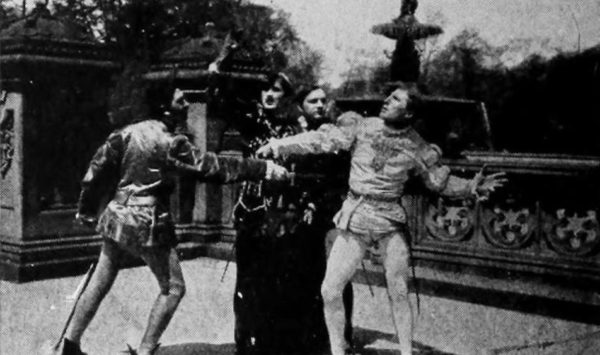
******************************************************************************************************************************** Brownstone Detectives investigates the history of our clients’ homes. The story you are about to read was composed from research conducted in the course of one of those investigations. Do you know the history of YOUR house? ******************************************************************************************************************************** The City of Brooklyn’s street grid system was still in its infancy in 1860, some 25 years after it had originally been laid out in Brooklyn maps in 1835. As builders began to buy up land, and as city elders watched the progress of speculative construction move continuously eastwards, it became apparent that some adjustments to the street grid were going to be necessary. SHAKESPEARE TO THE RESCUE Throughout the early 1860s, various New York State legislators from Kings County – likely in consultation with builders, land owners, and lawyers – began to plan these adjustments. These adjustments would come into being in two ways: 1) as extensions of certain streets through land that had originally been planned for building purposes, as well as 2) the closures of certain other portions of streets that had made other parcels of land unusable for building purposes. Thus, a legislative amendment to the Commissioners’ Map of the City of Brooklyn was in the works, and Brooklyn senators, having consulted professionals on the proposed changes, got to work on the wording to make the needed adjustments. In the end, six adjustments would be proposed – one of which was the creation of the very Shakespearean street moniker, Verona Place. “WHAT’S IN A NAME?” Considering the […]
A STREET GROWS IN BROOKLYN (1845)
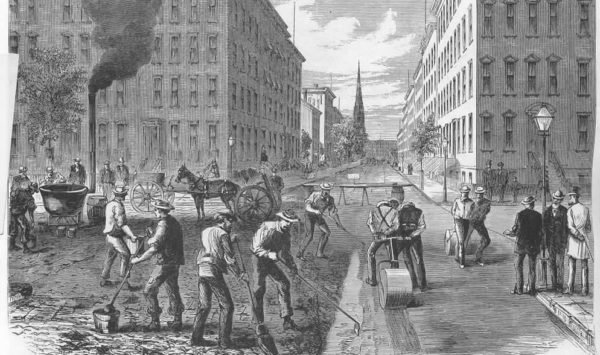
******************************************************************************************************************************** Brownstone Detectives investigates the history of our clients’ homes. The story you are about to read was composed from research conducted in the course of one of those investigations. Do you know the history of YOUR house? ******************************************************************************************************************************** The growth of brownstone Brooklyn took place over a great many years. The long contiguous lines of rowhouses rocketed skywards across the city through the economic good times, as well as – at a less robust pace – through the many debilitating recessions. But rocket they did, leaving the footprints of the many contractors and builders who changed the landscape of Brooklyn into a City of Houses. Another mark that the contractors and builders left – although one not as celebrated today – was the complicated system of flagging, pipes, sewers, cisterns, streetlamps, and sometimes trolley tracks, that lined the streets and led to those very rowhouses. Each delivery and receiving system that connected each rowhouse to the city was an important step toward the development of the city. Before each row of houses was constructed (and sometimes while they were being constructed, or even soon afterwards), the development of each street and neighborhood was an important part of attracting the homeowners to Brooklyn. THE BIRTH OF BOERUM HILL Boerum Hill had only recently been planned for with a street grid system that would develop alongside of a vast network of sidewalks, sewers, street lamps, gas lines, and water mains. At this time, however, in the 1840s, it barely resembled such […]
THE “IMPOSING” VIEW FROM OCEAN HILL (1848)
******************************************************************************************************************************** Brownstone Detectives investigates the history of our clients’ homes. The story you are about to read was composed from research conducted in the course of one of those investigations. Do you know the history of YOUR house? ******************************************************************************************************************************** Before there was Ocean Hill—the Bedford-Stuyvesant neighborhood—there was Ocean Hill—the section of Green-Wood Cemetery. Whether one influenced the other is lost to the ages. What is clear, however, is that both locations got their names from a geographical point from which a body of water could clearly be viewed. “At this point, now known as Ocean Hill,” described a contributor (whose pen-name, revealingly, was Investment) in an edition of the Brooklyn Daily Eagle published just a few years before the Civil War began, “we have reached the highest point on the avenue (Fulton Street) and the most commanding elevation of ground in the city; and which, for grandeur, beauty and variety of its scenery, cannot be surpassed. “The ocean view,” Investment continued, “is especially grand and imposing.” Investment, whose contribution to the paper existed as a thinly veiled promotional piece for Brooklyn, was describing the “advance in the value of Brooklyn real estate.” From Fulton Ferry he advanced down Fulton Avenue to “gather such information as will enable the public to form an intelligent estimate as to the present and prospective value of property on and near this great thoroughfare.” “At this point Fulton avenue is distant but a few hundred feet from Atlantic avenue on the south, and Broadway on […]
“THE HATS TEMPTED MARY” (1890)
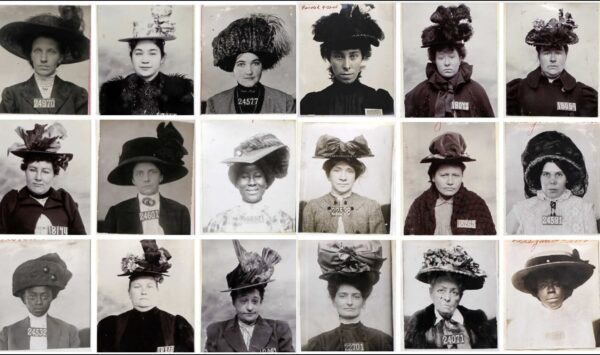
******************************************************************************************************************************** Brownstone Detectives investigates the history of our clients’ homes. The story you are about to read was composed from research conducted in the course of one of those investigations. Do you know the history of YOUR house? ******************************************************************************************************************************** A cursory search through old newspaper archives of the 1890s and early 1900s will produce a large number of incidents whereby patrons of dry goods, and other such stores, were summarily and stealthily robbed by clandestine crooks. Solomon Milkman’s Millinery House – at 442 & 444 Fulton Street – was no exception. A wholesale hat store primarily patronized by women, it soon became the target of thieves looking for money packaged in tiny, easily hidden and transportable containers – purses. The first thieves, though, saw the store itself as the easy target. Usually women, they pilfered mostly feathers, buttons, and other accouterments for the embellishment of women’s hats. In 1890, the first of Milkman’s thieves made the morning papers when a wealthy South Brooklyn woman was caught red-handed, so to speak, stealing goods valued at $3. She would not give her name to the police, as her husband was well-known, so they referred to her as Jane Doe. The police kept her – and her husband’s – identities secret and allowed the wealthy businessman husband of hers to escape humiliation. The following year, in 1891, Nora Duffy, 19, of 79 Sackett Street, was the next identified thief. A “tawdrily dressed young woman,” she was noticed by a detective of Wechsler & […]
B’KLYN GALS SEEK LEAP YEAR COWBOYS (1912)
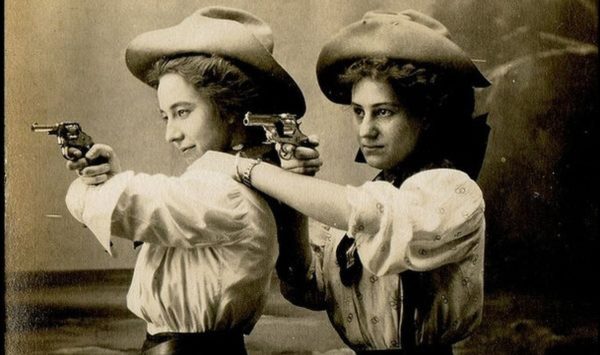
******************************************************************************************************************************** Brownstone Detectives investigates the history of our clients’ homes. The story you are about to read was composed from research conducted in the course of one of those investigations. Do you know the history of YOUR house? ******************************************************************************************************************************** “Come on boys; don your riding chaps, brush up your sombrero and dig out your rusty six-shooter and look-like a moving picture hero!” So started the article in the Sacramento Bee in April of 1912 about two Brooklyn sisters who were looking far afield for long-distance leap year affairs. Alma and Lou Bahn of 546 Washington Avenue, a boarding house between Fulton Street and Atlantic Avenue known as The Berwick, were taking this leap year business seriously, it seemed, and the men of the borough of Brooklyn, it seemed, could not hold down the sisters’ adventuresome spirits. “They want to correspond with you and perhaps the corresponding may lead to love and to the altar,” continued the Bee story. “The girls apparently realize that California is overrun with cowboys and that some of them are so dare devil and roguish that they buy their chewing gum in cigar stores,” continued the Bee. “Therefore, they ask for the names of several in order that they can each pick out a ‘nice’ cowboy and not a Black Bart the second or a California Jesse James. “The Brooklyn belles do not give their ages, but their pictures indicate that they are, or were, young. That they are not idle flirts seeking to catch some […]
BROOKLYN’S FIRST GENTRIFIER (1814)
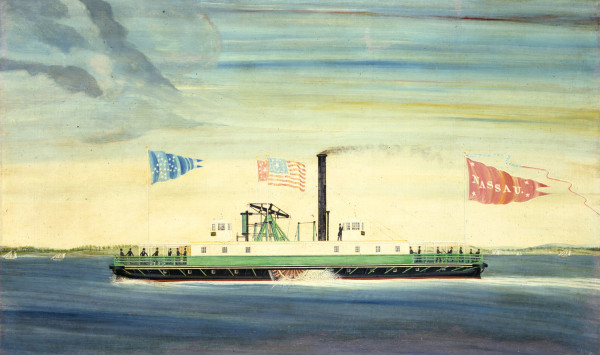
******************************************************************************************************************************** Brownstone Detectives investigates the history of our clients’ homes. The story you are about to read was composed from research conducted in the course of one of those investigations. Do you know the history of YOUR house? ******************************************************************************************************************************** It was the evolution and availability of transportation which initiated this whole Brooklyn gentrification hubub. But it started earlier than most people realize – in 1814. HOW A FERRY RIDE HELPED MAKE BROOKLYN THE ORIGINAL SUBURB A 2014 New York Times article laid out the story of how Manhattanites began their adventures in outer borough living – specifically, Brooklyn – when they started looking for cheaper digs and some lebensraum, or “elbow room,” in 1814. Regular ferry service, from Manhattan to Fulton Street in Brooklyn, started in that year when the twin-hulled Nassau, of the Fulton and South Ferry Company, carried “549 passengers, one wagon and three horses” to the borough. AMERICA’S FIRST COMMUTER Was Brooklyn where it all began? The New York Times article noted that the first man to board that ferry on 10 May of 1814 could “justly be called America’s first commuter.” Whether this claim is justifiable or not, another claim might be “justly” made: The ferry service which began on that day could arguably have kick-started the birth of gentrification. Throughout the century, as workers on Manhattan sought and found affordable housing in Brooklyn, farmers were pushed from the land. Like many selling their brownstones in Brooklyn today, though, they made tidy profits in the exchange, […]
PARDONED THAT HE MAY HANG (1905)
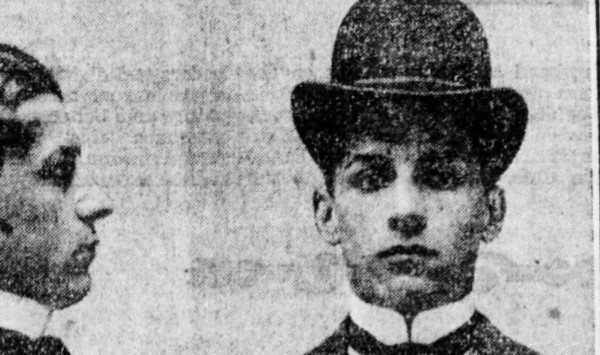
******************************************************************************************************************************** Brownstone Detectives investigates the history of our clients’ homes. The story you are about to read was composed from research conducted in the course of one of those investigations. Do you know the history of YOUR house? ******************************************************************************************************************************** He was a “desperate young crook,” according to the Governor of New York. But the governor went ahead and pardoned him anyway. Charles Bassett, 19, of Brooklyn, had committed enough crimes that the State decided that he needed to be put away for eight years in Sing Sing. Amongst other felonies, he “broke into Nicholas Weinberg’s jewelry store on Fifth Avenue” and “assaulted Jeweler Bridger and stole his diamond on Fulton Street.” And these were the crimes that they knew about. Bassett was a bad apple – plain and simple. But Governor Higgins in an agreement with Connecticut’s governor, made a deal that scared and surprised everyone. And in the process, he practically opened Bassett’s cell door himself, escorted him through the yard, and watched as he walked out the prison gates. ROBBING PETER TO PAY PAUL These listed crimes, however, were but mere child’s play when his solitary darker and fouler crime was taken into account. As all good thieves do, Bassett had a criminal network to which he belonged. As soon as there was a chance to make a quick buck without having to do work of any kind, Bassett could smell the opportunity. In Bridgeport, Connecticut, a $20,000 haul was the glimmering bauble that lured Bassett’s attention. It […]
WONG SING BOW’S WHITE WIFE MINNIE (1877)
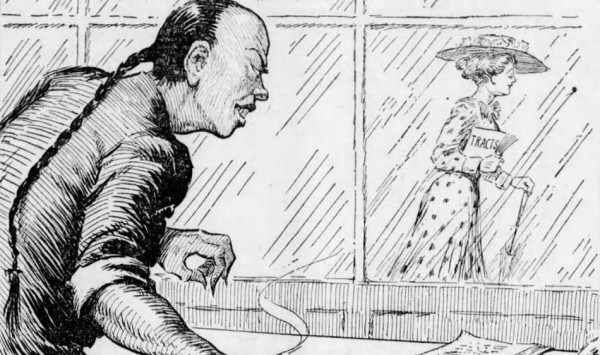
******************************************************************************************************************************** Brownstone Detectives investigates the history of our clients’ homes. The story you are about to read was composed from research conducted in the course of one of those investigations. Do you know the history of YOUR house? ******************************************************************************************************************************** In 1886, the life that Wong Sing Bow had been building up for years began to crumble before his eyes. A naturalized U.S. citizen, Wong Sing had been born “a subject of the emperor of China.” But he had been in America “long enough to save considerable money and to appreciate the beauty of Irish girls,” said one paper of the time. Wong Sing spoke English fluently and was often called upon by the authorities to interpret. With all that Wong Sing had going for him, it had originally seemed likely that he was going to have a good life. But this was the 1800s. And Wong Sing was Chinese. ANTI-CHINESE PREJUDICE IN 19TH CENTURY BROOKLYN After Wong Sing’s arrival in the U.S. around 1870, according to one paper, “the celestial youth immediately fitted himself in the groove of circumstances. “He decided to become intensely American. He shaved his cue off, doffed his Chinese garb, proclaimed his intention to become a citizen, and went to Sunday school ‘all samme like Melican man.’” Apparently, the papers, like most Americans, had no politically correct bent in those days. But the Chinese were located squarely at the bottom of the social construct – just slightly beneath the Irish and the Germans – and so […]
THE FUR-MAN OF FULTON STREET (1896)
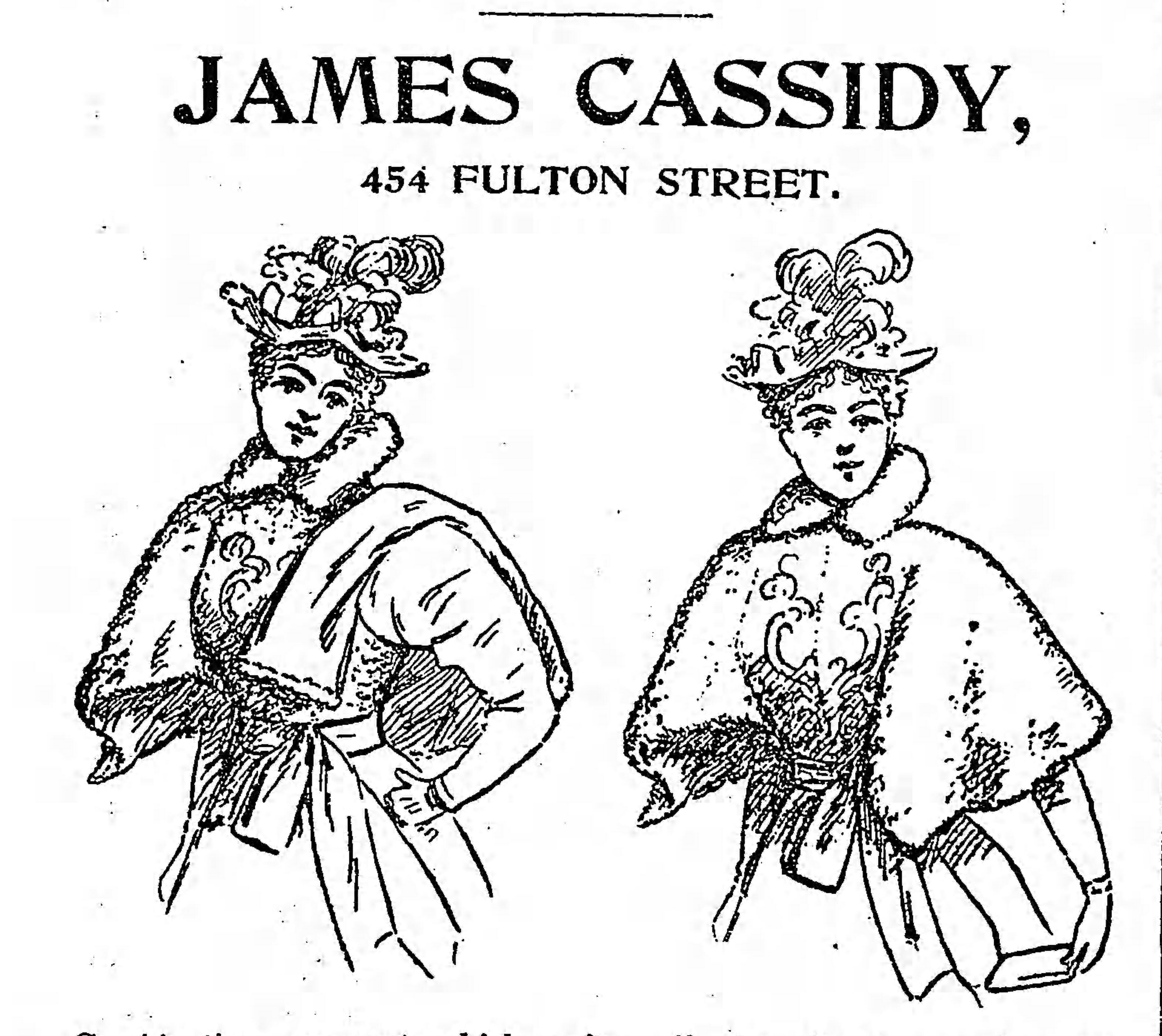
Fur was a big thing 100 years ago. The highest classes of women wore furs and those not as high a class wished to emulate them. There were all types of furs – from lynx, to fox, to otter and seal – even mole, squirrel and Persian sheep! James Cassidy not only sold the finest furs in the latest styles, but he also altered them as the styles changed, repaired them when they became damaged, and then refrigerated them in the summer when they were not in use. After a fur was selected, altered, and sold, it also needed to be cared for. So an entire industry sprang up around their cold storage in the warmer months. Cassidy used the latest in refrigeration techniques – an ammonia refrigerating machine – a freezing method which “far surpasses the old.” With refrigeration at hand within the same building where the furs were sold, an employee of Cassidy’s would simply send a wagon around to their client’s door and pick up their furs, bringing them back to Cassidy to summer in his cold storage. CASSIDY MOVES DOWN FULTON Cassidy’s fur emporium at 454 Fulton Street, a new “four-story brick building” in 1889, allowed him to expand his operations as he moved from his former shop at 277 Fulton Street. He held his grand opening later that year on October 29th. By 1900, Cassidy’s son, James, Jr., was running the business. In 1902, Although Cassidy continued to operate his store from this location, he […]
DID BROOKLYN GIRLS SMOKE? (1887)
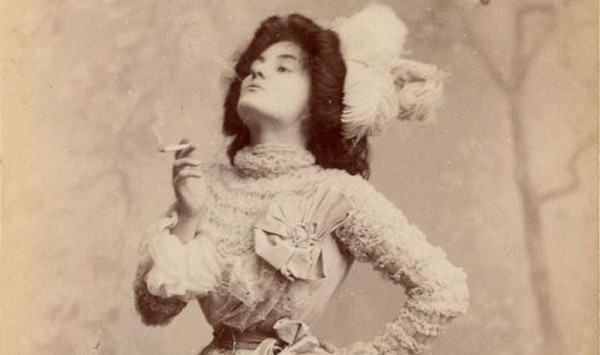
******************************************************************************************************************************** Brownstone Detectives investigates the history of our clients’ homes. The story you are about to read was composed from research conducted in the course of one of those investigations. Do you know the history of YOUR house? ******************************************************************************************************************************** “There are more women in the City of Brooklyn who smoke cigarettes than any one…would ever dream of.” So floated the words of a Fulton street cigar store proprietor one evening in 1887, after a boy “of 12 or 13 years of age” entered and asked him for “a package of the same kind she got last night.” I was paid to find out why. So, going to the source, I found a few men who talked. Actually, they sang like canaries. And I kept good notes. TRACKING A RUMOR TO ITS SOURCE The cigar store I walked into was doing a brisk business. But the customers were men. All men and, from time to time, a few boys. Playing the bored customer, I perused the tobacco boxes, fiddled with the cigar cutters, and then spotting the proprietor – rather he spotted me! – he struck up a conversation. Like most customers who either didn’t know what they were looking for or had ulterior motives, I told him that I was just browsing. Taking him into my confidence just then, I asked him where all of his female customers were. Arching an eyebrow, he shot me a knowing glance, patted the side of his nose, and waved a hand before me, […]